The most comprehensive information about solar pool pumps anywhere. You'll feel like an expert in no time.
Solar pool pumps have many benefits. Your family can save with Federal solar rebates and monthly utility savings.
You and other pool owners of your community can share the benefits of owning a solar power pool pump.
Solar energy: what you need to know
Solar power is usable energy generated from the sun in the form of electric or thermal energy. Solar energy is captured in a variety of ways, the most common of which is with photovoltaic solar panels that convert the sun’s rays into usable electricity. Aside from using photovoltaics to generate electricity, solar energy is commonly used in thermal applications to heat indoor spaces or fluids. Residential and commercial property owners can install solar hot water systems and design their buildings with passive solar heating in mind to fully take advantage of the sun's energy with solar technology.
Interested in benefiting from solar power? Solar panels are installed at three main scales: residential, commercial, and utility. Residential-scale solar is typically installed on rooftops of homes or in open land (ground-mounted) and is generally between 5 and 20 kilowatts (kW), depending on the size of a property. Commercial solar energy projects are generally installed at a greater scale than residential solar. Though individual installations can vary greatly in size, commercial-scale solar serves a consistent purpose: to provide on-site solar power to businesses and non-profits. Finally, utility-scale solar projects are typically large, several megawatt (MW) installations that provide solar energy to a large number of utility customers.
For some solar shoppers who may not be able to install solar on their property, community solar is a viable solar option that more directly connects utility-scale solar energy projects to residential consumers. As such, community solar farms are typically built in a central location as opposed to on any single customer’s property. Residential consumers can subscribe to a community solar project to receive many of the benefits of solar power without installing solar panels on their property.
https://news.energysage.com/how-solar-photovoltaic-cells-work/
A brief history of solar power
In 1954, Bell Labs developed the first silicon photovoltaic cell. Although solar energy had previously been captured and converted into usable energy through various methods,only after 1954 did solar power begin to become a viable source of electricity to power devices over extended periods of time. The first solar cells converted solar radiation to electricity at an efficiency of 4 percent - for reference, many widely available solar panels today can convert sunlight to solar power at above 20 percent efficiency, a number constantly on the rise.
Although adoption of solar energy was slow at first, a number of state and federal incentives and policies contributed to driving down the cost of solar panels far enough to become more widely adopted. At this point, solar power accounts for enough capacity to power 11 million of the 126 million households in the country.
The cost of solar energy
Concurrent with an increase in solar panel efficiency, the cost of solar energy has fallen substantially. In the last decade alone, the cost of a solar panel installation fell over 60 percent, and many industry experts predict that prices will continue to fall in the years to come:
solar energy cost over time
Additionally, depending upon where you live, several rebates or incentives for solar power may contribute towards lowering the cost of solar energy even further. Nationwide, the federal Investment Tax Credit (ITC) is one of the primary incentives available to anyone interested in solar energy, as it allows you to deduct 30 percent of the cost of installing a solar system from your federal taxes. Many states and utilities offer further incentives (such as net metering) in addition to the federal ITC, dropping the cost of solar power even further.
Solar energy is a renewable power source
Solar energy is a clean, inexpensive, renewable power source that is harnessable nearly everywhere in the world - any point where sunlight hits the surface of the earth is a potential location to generate solar power. And since solar energy comes from the sun, it represents a limitless source of power. Renewable energy technologies generate electricity from resources that are infinite. Compare, for instance, producing electricity with renewable resources to doing so with fossil fuels. It took hundreds of thousands of years for oil, gas and coal to form, so every time one of those resources are burned to create electricity, that finite resource is moved marginally closer to depletion. Using a renewable resource - such as wind, solar and hydropower - to generate electricity, does not deplete that resource. There will always be consistent sunlight shining on Earth's surface, and after turning sunlight into electricity, there is still an infinite amount of sunlight to turn into electricity in the future. That is what makes solar power, by nature, renewable energy.
While the current electricity mix in the United States is still made up largely of fossil fuels like oil and gas, renewable energy sources like solar are steadily becoming a larger part of the country's energy profile. As the cost of solar and other renewable technologies continues to be competitive.
Why Go Solar
Go solar: top 10 benefits of solar energy
There are many reasons why homeowners go solar, but improving the environment and cutting energy costs are the most common. Many people are aware that solar is a great home efficiency upgrade and are eager to reduce their carbon footprint while also improving property value.
Whether your motivations for going solar are economic, environmental, or personal, this sizable list of solar power beenfits will have something for everyone. Here are the top ten reasons why solar energy is good for your home and more popular than ever in the United States.
1. Drastically reduce or even eliminate your electric bills Whether you’re a homeowner, business, or nonprofit, electricity costs can make up a large portion of your monthly expenses. With a solar panel system, you’ll generate free power for your system’s entire 25+ year lifecycle. Even if you don’t produce 100 percent of the energy you consume, solar will reduce your utility bills and you’ll still save a lot of money. Learn more return on solar investment 2. Earn a great return on your investment Solar panels aren’t an expense – they’re one of the best ways to invest, with returns rivaling those of more traditional investments like stocks and bonds. Thanks to substantial electricity bill savings, the average American homeowner pays off their solar panel system in seven to eight years and sees an ROI of 20 percent or more. Learn more rising energy costs 3. Protect against rising energy costs One of the most clear cut benefits of solar panels is the ability to hedge utility prices. In the past ten years, residential electricity prices have gone up by an average of three percent annually. By investing in a solar energy system now, you can fix your electricity rate and protect against unpredictable increases in electricity costs. If you’re a business or homeowner with fluctuating cash flow, going solar also helps you better forecast and manage your expenses. Learn more increase property value 4. Increase your property value Multiple studies have found that homes equipped with solar energy systems have higher property values and sell more quickly than non-solar homes. Appraisers are increasingly taking solar installations into consideration as they value homes at the time of a sale, and as homebuyers become more educated about solar, demand for properties equipped with solar panel systems will continue to grow. Learn more 5. Boost U.S. energy independence The sun is a near-infinite source of energy and a key component of achieving energy independence in the United States. By increasing our capacity to generate electricity from the sun, we can also insulate our country from price fluctuations in global energy markets. Learn more solar jobs 6. Create jobs and help your local economy According to The Solar Foundation, the solar industry adds jobs many times faster than the overall U.S. economy. This growth is expected to continue. Because solar-related jobs tend to be higher paying and cannot be outsourced, they are a significant contributor to the U.S. economy. Learn more leaf 7. Protect the environment Solar is a great way to reduce your carbon footprint. Buildings are responsible for 38 percent of all carbon emissions in the U.S., and going solar can significantly decrease that number. A typical residential solar panel system will eliminate three to four tons of carbon emissions each year—the equivalent of planting over 100 trees annually. Learn more 8. Demonstrate your commitment to sustainability Sustainability and corporate social responsibility are important components of an organization’s culture and values. They also produce bottom line results. Increasingly, consumers and communities are recognizing and rewarding businesses that choose to operate responsibly. Businesses are finding that “green” credentials are a powerful driver of consumer purchasing decisions, creating goodwill and improving business results.
Solar Panels for Businesses: Does Commercial Solar Make Sense?
If you’re a business owner, the concept of “solar panels for businesses” might seem like a risky move in a complex and confusing market. You may have heard about major Fortune 500 companies going solar, but thought that it might not be feasible for your organization. Maybe you’re considering installing solar panels at some point in the distant future, when your organization can afford to make a major investment in something that seems like an environmental “good” rather than a strategic financial decision.
Time to shake off that old way of thinking and join the growing chorus of smart business owners that have discovered that commercial solar panels are a great fit for a small to mediums sized business. Solar isn’t just for Intel and Wal-Mart anymore. Businesses of all sizes are capitalizing on the financial opportunities of installing solar, proving that a solar energy system is a key strategic decision that virtually guarantees a solid financial return for your business.
9. Increase employee morale
Just like consumers, employees have a demonstrated appreciation for their employers’ commitment to operating responsibility. Employees share in the success and contributions of their organizations. Companies that care about their community and environment tend to have lower turnover rates, more engaged employees, and higher levels of morale.
10. Stay competitive
Companies quickly are realizing the social and economic benefits of adopting solar power. As early adopters pull ahead of the competition, many companies are exploring solar power as a way to keep up.
Eliminate Electric Bills:
Solar saves on energy costs and electric bills
Eliminate or significantly reduce your electric bill with solar energy
One of the biggest reasons to go solar is that you can eliminate or significantly reduce your electric bill. An average monthly electric bill of $100 becomes an annual $1,200 expense. Over 20 years, that same $100 monthly bill balloons to $24,000 paid to your utility, and that’s before factoring in electricity rate increases that will likely make your 20-year energy costs even higher. Installing a solar panel system at your home or business takes you out of this cycle.
Going solar can eliminate your electric bill completely or reduce it so dramatically that electricity costs are no longer a significant factor in your budget. Your savings with solar depend on a few different factors, like how much energy your system produces and how much you consume, but the biggest factor is the rates you would otherwise pay to your utility.
Because your savings are equal to the costs you avoid by going solar, you’ll save even more if electricity rates are high in your area. And, since electricity prices will continue to rise, your savings will continue to grow every year over the 25+ year lifespan of your solar panel system.
Reducing one of your largest monthly expenses makes perfect sense, but the benefits of solar aren’t just economic. Because electricity prices can be unpredictable, they make managing your budget difficult. By installing a solar panel system, you also fix your electricity costs and make them more predictable. This is especially beneficial for anyone with a fixed income, as well as for businesses who stand to gain from a more stable cash flow. When you make your electricity costs more predictable by going solar, you also improve your expense forecasting and management capabilities.
Earn Great Returns:
Solar panel ROI: what returns can I earn on my solar investment?
Last updated 2/28/2019
In many ways, your solar power system is a financial product – one that is capable of generating annual returns ranging anywhere from 10 percent to more than 30 percent. The average EnergySage shopper pays off their solar purchase in just seven to eight years and earns a strong solar ROI, receiving free electricity for the remainder of their solar panel system’s 25+ year lifespan.
You can calculate your annual returns by dividing the financial benefits you receive each year by your initial investment in your solar power system. Many factors can impact your solar panel ROI, including:
Electricity Rates: How high are your current electric bills? This determines your savings over the life of your system. The higher your rates, the more you can save with solar.
Financial Incentives: Are there local or state tax programs or rebates in your area that encourage solar adoption? Are you a business or other organization that can take advantage of depreciation tax benefits, including accelerated depreciation? Higher incentives mean lower upfront costs and a shorter payback period.
Solar Renewable Energy Certificates (SRECs): Does your state or utility have a market where you can sell the SRECs associated with your solar energy system’s electricity? What kind of income can you earn by selling these SRECs? New income from SRECs will help you break even on your solar investment more quickly.
Cost: Did you compare your options to find the right price? Were you able to take advantage of rebates and tax incentives that offset the cost of your installation? Lower costs mean a shorter payback period.
Technology: How efficient is your system, i.e. is it producing electricity at optimal levels? A more efficient system will offset a greater percentage of your monthly electric bill.
Property Characteristics: How sunny is it where you are? Which way does your roof face? What is the pitch of your roof? All of these factors can affect your production levels.
Property Value Increases: How much does the value of your property increase when you install a solar panel system? Solar panel system ownership tends to increase your property resale value, while third party ownership (e.g. leasing) does not.
Business Benefits: How much will your profits increase because of your lower costs? What is the value of the goodwill your solar power system generated? What level of revenues is attributable to your green credentials? All of these factors can increase your company’s return on solar investment.
Solar payback period = solar panel ROI
Taking all of the above factors into consideration, you can get an idea for what your solar payback period might be, which is the best way to put a number on your solar panel ROI. A solar panel payback period is the amount of time it will take you to earn back the money you spend upfront on a solar energy system, usually in the form of avoided electricty costs.
For example, if your solar panel payback period is 7 years, after that length of time, you can easily calculate your actual monetary solar panel ROI by simply looking at your electricity usage and local electricity rates. If you usually use 1,000 kilowatt hours (kWh) of electricity a month at $0.15 per kWh, that's $150 you would spend on electricity per month without solar. With solar installed (and after your payback period is up), each month you essentially pocket $150. This money saved ends up being even more per month over time, as electricity rates historically rise over the years.
Avoid Utility Inflation:
Protect yourself from rising utility costs
Without a doubt, the long-term trend for electricity prices is upwards. Over the past decade, electricity prices have risen by an average of three percent each year. Eliminating or significantly reducing these costs will save you a lot of money in the long run. By going solar, you also protect yourself against rising prices and make your monthly bills more predictable. With solar you produce your own energy, so it takes away the anxiety associated with rising and fluctuating energy prices.
How solar reduces your electric bill
Let’s assume electricity prices will continue to rise by three percent each year. The typical U.S. home spends about $1,340 annually on electricity. If you buy a system that meets 100 percent of your electricity needs today, you will have an extra $1,340 in your pocket a year from now. The following year, when prices go up, you’ll save about $1,380. Your savings will continue to grow for the 25+ years that your panels generate electricity, adding up to well beyond $30,000 over the lifespan of your system.
Even if you don’t have the cash to buy a solar energy system up front, you can still reduce energy costs by financing your solar panel system with a solar loan, solar lease, or solar power purchase agreement (PPA). Most solar financing options require no money down and reduce your monthly expenses from day one of installation. As an added benefit, your monthly energy costs will no longer fluctuate – they will simply be the monthly amount of your loan or lease payment.
You’ve exchanged one expense for another, but your new expense is:
Predictable
Lower than your pre-solar electric bill
Consistent over time, without any fluctuations or increases
Increased Property Values: Solar panels increase property values Last updated 4/22/2019
Increase home value 3-4% by installing a solar panel system
Multiple studies have shown that homes with solar panel systems are valued and sold at prices above similar homes in their area. Early studies focused on established solar markets such as California found that home values increase by four percent or more when homes are equipped with solar panels. Lawrence Berkeley National Laboratory, a research laboratory affiliated with the Department of Energy, continues to expand on that research as solar grows across the U.S.
Early studies focused on established solar markets such as California found that home values increase by four percent or more when homes are equipped with solar panels. Lawrence Berkeley National Laboratory, a research laboratory affiliated with the Department of Energy, continues to expand on that research as solar grows across the U.S.
The Lab’s 2015 Selling Into the Sun report analyzed sales of solar-equipped homes in eight different states over 11 years with the goal of determining just how much value solar adds to a home’s sale price. The key finding: on average, homebuyers are “consistently willing to pay PV home premiums” of approximately $4 per watt of installed solar capacity (note: this study only covered homes where the solar PV system was owned, not leased). For a standard 6-kilowatt solar PV system, this means that solar can add $24,000 to your home’s resale value.
Can your property value increase if you lease your solar panels?
Installing solar panels on your home can increase its value, but only if you own the system. If you install a solar panel system through a lease or PPA, you are essentially “renting” it from the third-party owner. Since you don’t own the system, it cannot be included in assessments of your home’s value. Most studies about solar and home values focus exclusively on owned solar energy systems.
Many of the same factors that drive your overall financial returns also drive increases in property values. Not surprisingly, the largest increases are in areas where electricity rates are high and strong solar incentive programs exist. All of this is great news for property owners with solar PV systems: they not only recoup the initial cost of their systems when they sell, but also receive a premium that will increase their returns on their investment.
Recognizing that solar power systems add value to a property, the real estate industry is working to create more sophisticated methods for accurately determining the market value of solar, as well as the financial value of properties equipped with solar power systems.
U.S. Energy Independence:
U.S. energy independence Last updated 2/28/2019
Solar power makes energy independence possible
The sun is a near-infinite source of energy and one of the world’s greatest resources. One recent study found that 25,000 square miles of solar panels (an area roughly the size of West Virginia) would generate enough electricity to power the entire world. By investing in solar power, you can help take advantage of the sun’s abundant resources and bring the United States one step closer to energy independence.
Global energy markets are notoriously unstable, and price fluctuations can have a serious impact on the U.S. economy. When we expand our capacity to generate solar electricity within the U.S., we also insulate ourselves from those price fluctuations and ensure a sustainable source of energy for the future. Even Saudi Arabia, one of the world’s largest oil producers, recognizes the economic and political benefits of solar energy: in 2012, the country announced a goal to build 41 gigawatts of solar capacity by 2032.
Create Jobs:
Solar energy creates jobs Last updated 2/28/2019
Help grow your local economy with solar energy
The financial benefits of going solar make a compelling argument for homeowners and businesses, and the overall impact of solar on the economy is just as positive. The solar energy industry is a national industry that provides high-quality jobs across the country. As more homes and businesses go solar, job opportunities continue to grow.
Findings from The Solar Foundation's 2017 Solar Jobs Census, while slightly outdated at this point, underscore that growth:
Since 2010, solar industry employment has grown by 168 percent, reaching nearly 250,000 jobs in 2015.
The solar industry employs twice as many workers as the coal industry.
Nearly 10 percent of solar jobs in the country are held by veterans, a much higher proportion than in the overall economy.
The clean energy economy offers more opportunities and better pay for low-and middle-skilled workers than the national economy as a whole. Wages for solar jobs in the U.S. are also significantly higher than the U.S.: the median wage for a solar installer in 2014 was $20 per hour, compared to $17.09 across the total U.S. workforce. Many solar installers are small locally owned businesses, and supporting them brings more money into local economies.
Solar power is a key source of energy in the U.S., and as the cost of solar continues to fall, all signs point to it becoming an even larger part of the U.S. energy supply. That’s good news for the economy and the environment.
Protect the Environment:
Renewable solar energy protects the environment Last updated 2/28/2019
Solar energy delivers environmental benefits
Many homeowners, businesses and non-profits go solar because they are focused on minimizing environmental issues like climate change and health problems related to carbon emissions. According to the U.S. Environmental Protection Agency, the average household emits approximately 20 metric tons of carbon pollution each year. By installing a solar power system, a typical two-person household reduces their carbon emissions by three to four tons annually.
The U.S. Green Building Council reports that buildings contribute 39 percent of all carbon emissions in the United States. Going solar helps to decrease these effects. While every home, business or non-profit that adopts solar power makes a dent in our pollution levels, the cumulative effect of property owners adopting solar across the country is what really makes a lasting impact.
How, exactly, does solar reduce greenhouse gas emissions? The electricity that solar panels produce is completely emissions free. When you use renewable solar energy to meet your energy needs, you reduce the demand for electricity from your utility. As a result, your utility plant emits less carbon when producing the power needed to meet customer demand. Depending on the resources that your utility uses to produce energy — many are still reliant fossil fuels like coal—the impact of your decision to go solar could be very significant.
Solar 101
What You Need to Know:
How does solar energy work? 10 things to know about photovoltaic (PV) solar panels
Last updated 1/11/2019
Solar photovoltaic (PV) systems – also known as solar panel systems, solar energy systems, or solar power systems – convert sunlight into electricity. You can use the electricity generated by your solar PV system to power your home, your business or even your car.
How solar energy works
1. Solar panel systems are a great way for you to save money, no matter what your budget is.
If you can afford to pay your electricity bill every month, you can afford to install a solar panel system. With a $0-down solar loan, solar lease or PPA, you can finance your system and see immediate savings.
2. Installing a solar panel system is a great investment.
Investing in a solar panel system can deliver better returns than stocks and bonds – and now is the right time to make that investment. While solar photovoltaic technology is improving incrementally each year, financial incentives and rebates will decrease as solar becomes more popular.
3. Solar photovoltaic systems have been around for a long time.
Solar photovoltaic systems are a well-proven technology first invented in 1954 by scientists at Bell Labs. Today, solar panels are installed on over one million homes in the U.S.
4. Solar panel systems are highly durable.
Solar photovoltaic panels are made of tempered glass and can withstand hail, snow, rain, and high winds. They can even extend the life of your roof by protecting it from daily wear and tear.
5. Solar power systems can produce electricity for 25 or more years.
Most solar panel manufacturers offer a 25-year power production warrantyguaranteeing that their solar panels will continue to generate electricity at a certain capacity for the warranty’s duration.
6. Solar power systems are practically maintenance-free.
Solar panel systems are incredibly durable. Except in extreme circumstances, they don't need to be washed or cleaned.
7. Solar panels can be installed almost anywhere in the United States.
Most locations in the United States get enough sunlight to produce sufficient electricity from solar panels. The most important factors to consider when you evaluate your solar panel options are the rates you pay for electricity and the rebates and incentives available to you.
8. Solar energy systems are tied to the electric grid and do not require batteries to store power.
When you install a solar energy system on your property, you remain connected to the electricity grid. At times when your system produces more electricity than you use, you receive credit for the electricity you send to the grid; if you need more electricity than your solar energy system is producing, you can draw it from the grid.
9. Solar power systems can eliminate most of your electricity bill.
With the right planning, your solar panels can generate enough electricity to meet your needs over a 12-month period. As long as you have enough roof space to install the right size solar panel system, the power that your panels will produce will effectively eliminate most of your electricity bill.
10. Solar photovoltaic panels can be installed on the roof of your home or commercial property, on the ground or on a solar canopy.
Solar panels can be installed practically anywhere that receives direct sunshine for most of the day and is not shaded by trees or buildings. Panels that face south will produce the most electricity, but your panels can also face east or west.
About Solar Electricity:
Solar electricity: How does it work? Last updated 5/10/2019
In 1954, scientists at Bell Telephone discovered that silicon, an element found in sand, created an electric charge when it was exposed to sunlight. This discovery led to the development of solar cells that captured the sun’s energy and turned it into electricity. Since then, the technology has evolved, and solar power systems now provide incredibly attractive financial benefits for homeowners, businesses and non-profits across the United States.
Thanks to solar panels, we have access to an inexhaustible source of power – the sun. Throughout the day, the cells on your solar panels absorb the energy from sunlight. Circuits within the cells collect that energy and turn it into direct current (DC) electricity. The DC electricity is passed through a device called an inverter to convert it to the alternating current (AC) electricity used by most homes and businesses. You can use that electricity in your home, store it with a solar battery, or send it back to the grid.
Solar panel diagram: how solar panels connect to the grid
Solar panel system components
Solar PV systems have four main components:
1. Solar photovoltaic panels ("solar panels")
2. Inverters
3. Racking and mounting system
4. Performance monitoring systems
Solar Panels
Solar panels collect and convert the sun’s energy into electricity. They are a key component of a solar panel system. Most commonly available panels today are either poly-crystalline or mono-crystalline solar panels.
The key differences between poly- and mono-crystalline panels are in efficiency and cost. Typically, mono-crystalline panels are more efficient (and thus more expensive) than poly-crystalline panels.
Racking and mounting systems
Racking and mounting systems are used to affix your solar panels either to your roof or to the ground. They also allow you to position your panels at an angle that is best for capturing the sun’s rays.
To perform at their best, solar panels should face south and be installed at an angle between 30 and 45 degrees (depending on how far you are from the equator). Panels facing east or west and at a pitch angle of five degrees or more will still work well, but will produce 10 to 20 percent less electricity than those installed under ideal conditions.
There are two types of mounts: fixed mounts, in which the panels remain stationary, and track mounts, which allow panels to “follow” the sun as it moves across the sky during the day (single-axis track mounts) and during the changing seasons (dual-axis track mounts). Track mounts are only suitable for panels installed on the ground.
The difference between Fixed vs. Track mount systems Fixed mounts are less expensive and the only option if you are installing your panels on your roof. Track mounts are more costly, but they allow you to increase your panels’ electricity production by 30 percent or more.
Because of their additional cost and increased maintenance, track mounts are best suited to situations where you have limited space and want to maximize the electricity production from a limited number of solar panels.
Performance monitoring systems
Performance monitoring systems provide you with detailed information about the performance of your solar panel system. With a monitoring system, you can measure and track the amount of electricity your system produces on an hourly basis.
While some solar installers charge extra for installing a monitoring system, it can provide significant value over the lifetime of your solar panels. Monitoring systems help you identify any performance issues to ensure that you maximize the electricity production (and therefore the financial returns) of your solar panel system.
There are two types of monitoring systems:
On-site monitoring: The monitoring device is physically located on your property and records the amount of electricity produced.
Remote monitoring: Your solar PV system transmits its performance data to a monitoring service that you can access online or with a mobile device
Types of Solar Panels:
Maintenance:
Solar panel maintenance Last updated 2/28/2019
Worried about solar panels and hail? Fret not, solar panel systems are incredibly durable and require little to no maintenance over their productive lifetime – which can span 25 years or more. In the event that something does go wrong, your solar PV system components have very long warranties that would cover replacement and repair costs. If you lease your solar panel system, repairs and maintenance are the leasing company’s responsibility, not yours.
Solar panel warranties
Solar panel manufacturers provide a range of warranties that guarantee you will have support and coverage in the unlikely event of an issue, such as hail or falling tree branches.
Power output warranties guarantee that panel performance won’t fall below a specified level over the term of the warranty (usually 25 years). For instance, a manufacturer might provide a warranty to guarantee that peak power output won’t fall below 85 percent for 25 years.
Some manufacturers will also include an additional warranty that promises a higher output level over a shorter period of time. As an example, a secondary warranty might guarantee no less than 90 percent of initial power output for the first 10 years.
Panels typically come with a workmanship warranty that protects consumers against defective panel parts, generally for the first five years of operation. Inverters also come with warranties, usually for 10 years.
Learn more about solar panel warranties and other indicators of quality in EnergySage’s Guide to Evaluating Solar Panel Quality.
How to maintain your solar panels Solar panels are made of tempered glass, so they’re built to withstand hail and other rough weather. With the exception of tracking mounts, solar panel systems don’t have movable parts, which cuts down on the possibility of any problems.
Any issues with solar panel performance are usually related to electricity production, which is why most installers recommend monitoring your system’s production. By paying attention to changes in production, you can identify and address issues proactively.
Generally, solar panels don’t need to be cleaned. If you live somewhere where there is a lot of smog, dust, or dirt, you may see a dip in your production over time that can be remedied by cleaning your panels. If your panels are mounted on your roof, however, your best option is to hire a professional cleaning service rather than try to clean them yourself. Your installer will be able to recommend someone local to help you.
Mounting solar panels in snow Many people in regions that get significant snowfall often ask if it’s necessary to remove the snow from the panels. Generally, the answer is no – snow usually melts and falls from the roof shortly after falling, so it doesn’t have a big impact on your overall production levels. For your panels to be self-cleaning, they will need to be mounted at an angle of 15 degrees or more.
Where to Install:
Solar panel installation
Last updated 2/28/2019
To maximize your solar panel system’s energy production, your system should be installed where the panels will be exposed to the most sunlight. This is why rooftop home solar installations are so popular. If your roof isn’t suitable for solar panels, you can also install the panels on the ground.
In an ideal home solar installation, your home would have a large, sunny, south-facing roof with a 30-degree pitch. However, you don’t need ideal conditions to benefit from solar power. Solar panels can be installed on most roofs so you can save on your electricity costs and help the environment, too.
Is solar installation suitable for where you live?
Even if you don’t live in a particularly sunny state, solar panels can still be a smart investment. The amount of money you save by going solar largely depends on two things: your electricity rates and the available solar rebates and incentives in your area.
As a result, the sunniest places in the country don’t always offer the greatest long-term savings from solar. In fact, consumers located in the Northeast can have significantly higher savings from solar power systems than homeowners in sunnier states such as Florida.
Get an instant estimate of your solar savings potential!
Is your roof suitable for solar installation?
Solar panel systems can be installed on most roofs. To determine whether a roof is suitable for solar, solar installers will look at:
Direction of the roof
South-facing roofs are ideal for solar because they get the most sunlight over the course of the day. However, a solar panel system on an east- or west-facing roof can still produce enough energy to reduce your electricity bills, save money and reduce your carbon footprint. Learn more about how roof orientation impacts electricity production.
Pitch angle of the roof
Solar panels can be installed on roofs with a pitch between 15 and 40 degrees. Even if your roof is flat, you can still go solar as long as you mount your panels at a good angle. Learn more about the impact of roof angle on electricity production.
The size and shape of your roof
It’s easiest to install panels on a large square roof. A general rule of thumb is that for every kilowatt of panels you want to install, you will need about 100 square feet of roof space. A typical home system will require about 500 square feet of space to install solar panels. Things like skylights, dormers, and chimneys will affect the amount of space available for a home solar installation. Generally, solar installers can design the layout of your panels around these obstructions in a way that maximizes your electricity production.
Shading on your roof
It is important that your roof gets enough sun throughout the day to maximize electricity production. Tall trees or buildings nearby can block the sun, cast shade on your roof, and reduce the amount of electricity your panels produce. You can trim trees so that more sun reaches your panels – doing so can actually have environmental benefits, though it might not seem that way.
Age of your roof
Solar panels can last for over 25 years, and removing them to replace your roof a few years after installation can be costly. Before you install your panels, make sure that your roof is in good shape and won't need to be replaced in the near future.
Material of your roof
Solar panels are compatible with most roofing materials, including composite, wood, cement tile, slate, tar and gravel, or metal. While you can install solar on slate, cedar, and clay tile roofs, they are more prone to breakage during solar panel installation. Make sure that you work with an experienced installer if your roof is made of these materials.
Solar operations and maintenance
Last updated 11/15/2018
You have solar panels on your roof – now what? Your solar energy system doesn't require much maintenance, but there are still a few products and services to consider once you've installed solar on your property.
Solar Warranties
Solar panel systems are extremely durable and require very little to no maintenance. Fortunately, if something does go wrong with your solar PV system, manufacturers of your equipment provide long warranties that will cover you if you have to repair or replace components.
Solar Panel Cleaning:
Solar panel cleaning: what you should know
Last updated 3/15/2019
Your solar panels need to be exposed to sunlight in order to produce power. However, unless you live somewhere with high amounts of smog, dust, dirt or sand blowing around, solar panel cleaning is generally not necessary. In most cases, occasional rain will be enough to naturally and safely keep your solar panels clean and free of debris that could lower production.
It may be a good idea to freshen up your panels occasionally if you live in an area with heavy particulates in the air. Here are answers to some of the top questions solar panel system owners have about cleaning solar panels and how to do it safely.
How to clean solar panels: what products should you use, if any?
When cleaning your solar panels, the most important consideration to keep in mind is that scratching or damaging the glass in any way will reduce a panel’s energy production. It’s best to approach panel cleaning the same way you might clean your car. Dish soap and warm water applied with a soft sponge or cloth is the safest and easiest cleaning method. It may also be helpful to use a squeegee to remove dirty water. Remember – avoid damaging or scratching the glass at all costs!
On rare occasions, oily stains can appear on your panels. You might find these if you live near a common truck route or an airport, and they can be tackled with a little isopropyl alcohol and a rag. It is essential to avoid using strong cleaning fluids, however, as these can streak and damage the glass.
Is it worth paying for a solar panel cleaning service?
Just like going to a car wash, there are professional options for cleaning solar panels – your solar installer may even do it for you, for a fee.
If you have a rooftop system, it may be a good idea to enlist a cleaning service, if only for safety reasons. Cleaning services won’t do a significantly different or better job than you can do yourself, but they are equipped to safely clean and maintain rooftop units. For ground mount units it may not be worth the service fee when you can safely and effectively clean your own panels with a hose, some dish soap, and a soft rag.
Does your solar lease cover panel maintenance?
In general, solar lease agreements do include a maintenance clause of some sort. Some companies will perform regular maintenance on their panels, and others will repair damages the customer reports. It is important to remember that solar panels generally require little maintenance, and simply spraying your panels down with a hose occasionally can do the trick.
Should you remove snow from your solar panels?
Snow on solar panels generally doesn’t need to be removed – it will typically slide off on its own. Most panel installations are tilted at an angle, and snow will naturally slide off as it melts. If snow persists on your panels, you can also invest in tools like a solar panel snow rake, which makes it easy to safely remove snow covering on solar panels. It is important not to use a standard broom, shovel, or other non-specialized tool to remove snow from panels, as they can scratch the panel glass and lower your power production.
Solar O&M Packages:
Solar operations and maintenance (O&M) packages
Last updated 1/11/2019
Solar operations and maintenance (O&M) packages are protection plans for your solar investment. You can think of them as a sort of “homeowner’s insurance” for your solar panels. If a tree falls on a portion of your house, home insurance plan will likely cover a large portion of the repair costs. The same is true of solar O&M plans.
If your solar system is underperforming, whether as the result of environmental, equipment, or other reasons, your O&M provider can perform physical repairs to your panels, inverters, or whichever portion of your array is affected. Solar operations and maintenance plans will also cover regular checks on your system to confirm that it is operating at peak performance.
Get an instant estimate of your solar savings potential!
Benefits of solar operations and maintenance packages
A strong solar operations and maintenance service package provides many benefits to residential customers. When you’re comparing your options, consider whether the following services are covered:
Site visits. O&M plans should include regular times throughout the year for your provider to come and physically inspect your solar system. From these site visits, your O&M provider will be able to diagnose problems with your system and take action to bring your electricity production back to normal.
Pest control. A common threat to solar systems is pests. Birds and rodents may nest in and around your array, leading to the potential for fires or electrical damage. Critter guards can help to alleviate this issue, but O&M companies often include pest control in their plan to counteract this common solar issue.
Cleaning. Well-designed solar panel systems rarely need cleaning. However, if you live in an area with high amounts of particulates and dust floating around, your O&M provider should if they find them losing efficiency due to dust or any other material dirtying your panels.
Electrical systems checks. Damage to the electrical systems connecting your solar array to your home and the grid need to be maintained as well. O&M plans should cover checks to all of your wiring and electrical systems that make sure the energy you produce is being transported and used correctly.
Solar inverter maintenance. Solar inverters (particularly string inverters) have a shorter lifespan than solar panels themselves, and need to be monitored closely for degradation. A good solar O&M plan will pay extra attention to your solar inverters to ensure your panels will be able to convert produced energy to usable electricity.
Hiring solar crew and personnel. In order to complete maintenance projects on your solar array, specialists and panel experts need to work with your system. A good solar O&M plan will find reputable repair crews to keep your panels maintained.
Importance of a solar service package
If your installer is available and you are still covered by their labor warranty, it is always best to first consult them for system maintenance – they know your system and equipment, and have a preexisting relationship with you. Even so, there are a few reasons why you may want to consider a separate O&M package.
Solar installers make their money from an initial installation. As a result, their priority may be focused on working with new customers, whereas a service package prioritizes your already-installed system. For the same reason, solar installers often send their best talent to work on new installations, rather than fix your damaged solar panels or inverters.
In some cases, your local solar installer may have gone out of business, meaning any installations they performed and were still under warranty no longer have a company to service them. Without a solar O&M plan, if your installer goes out of business you may not have an easy way to diagnose and fix issues with your solar array.
Independent Monitoring For Solar:
We can find it! Please enter pool address.
We help families become sustainable pool owners.
SunRay Solar Powered Pool Pumps

1/2HP Solar Pool Pump
Brush Type 72v Motor
2 PV Solar Panels
Above Ground PoolAfter Fed 30% $686
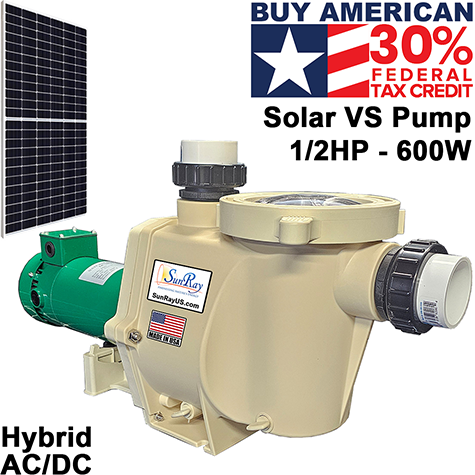
1/2HP Solar Pool Pump
Brush Type 72v Motor
2 PV Solar Panels
In or Above GroundAfter Fed 30% $804
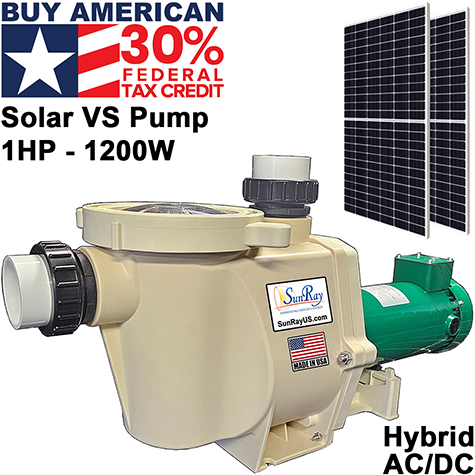
1HP Solar Pool Pump
Brush Type 105v Motor
3 PV Solar Panels
SunRay SolFlo1After Fed 30% $1119

1.5HP Solar Pool Pump
Brushless 120v Motor
4 PV Solar Panels
SunRay SolFlo2After Fed 30% $1749

2HP Solar Pool Pump
Brushless 180v Motor
6 PV Solar Panels
SunRay SolFlo3After Fed 30% $2099

3.5HP Solar Pool Pump
Brushless 240v Motor
8 PV Solar Panels
SunRay SolFlo4After Fed 30% $2799
Use the POWER of the Sun to run your pool pump!
Videos to Watch
We understand what it takes to run your swimming pool and pay the bills.
We also know what it feels like to be sustainable and off the grid. Join us!
Our future matters!
Buy a Solar Pool Pump.
Buy a Solar Pool Pump.
Why buy a SunRay
Solar Pool Pump?
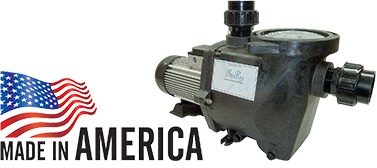
- SunRay Solar Pump PAYS FOR ITSELF… and then PAYS YOU to own it!
- Eliminates Pool Utility Cost!
- Complete Off-Grid Pool Operation!
- 30% Federal Tax Credit for 2019!
- Quick Return On Investment! (ROI)
- Lifetime of Pool Sustainability
SunRay Solar Powered Pool Pump Systems are packed with the latest in solar, controller, and motor technologies and specifically designed for the Residential and Commercial Pool markets. Our solar pumps are ideal for any size body of water including Pools, Spas, Fountains and Water Features. With more than 14 years of research and development behind our solar products, you can count on high performance American Engineered pump systems that are built to last and provide unprecedented energy savings. So much in fact, that it literally pays you to own a SunRay Solar Powered Pool Pump System.
A Pool Season to Remember!
how it works
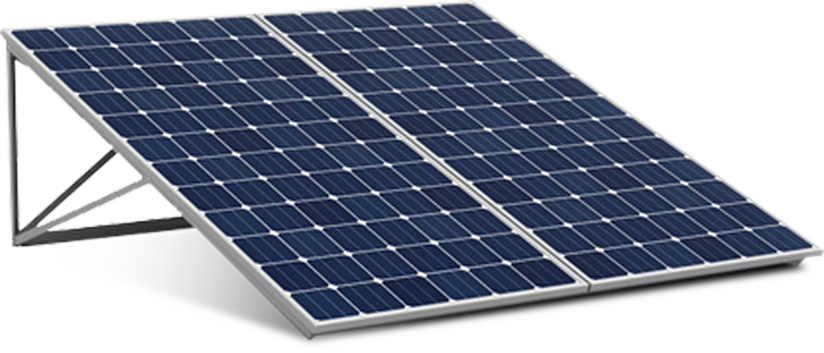
Starting with the Suns Gamma Ray, the Photo Voltaic Panels absorb these rays from sunrise to sunset. During this 12-hour period, this energy is sent from the PV panels through the DC disconnect to the SunRay DC Controller. This controller processes the FREE solar energy and sends it to the SunRay DC Brushless motor filter pump. This SunRay DC motor is truly variable speed and works naturally in the same way the other variable speed pump work. Starting slowly in the morning, running a close to maximum GPM for 6 - 9 hours per day, and then slows down as the sun goes down.

The Sun is all you need to care for your pool water.
Solar Pool Pump Technology Layouts
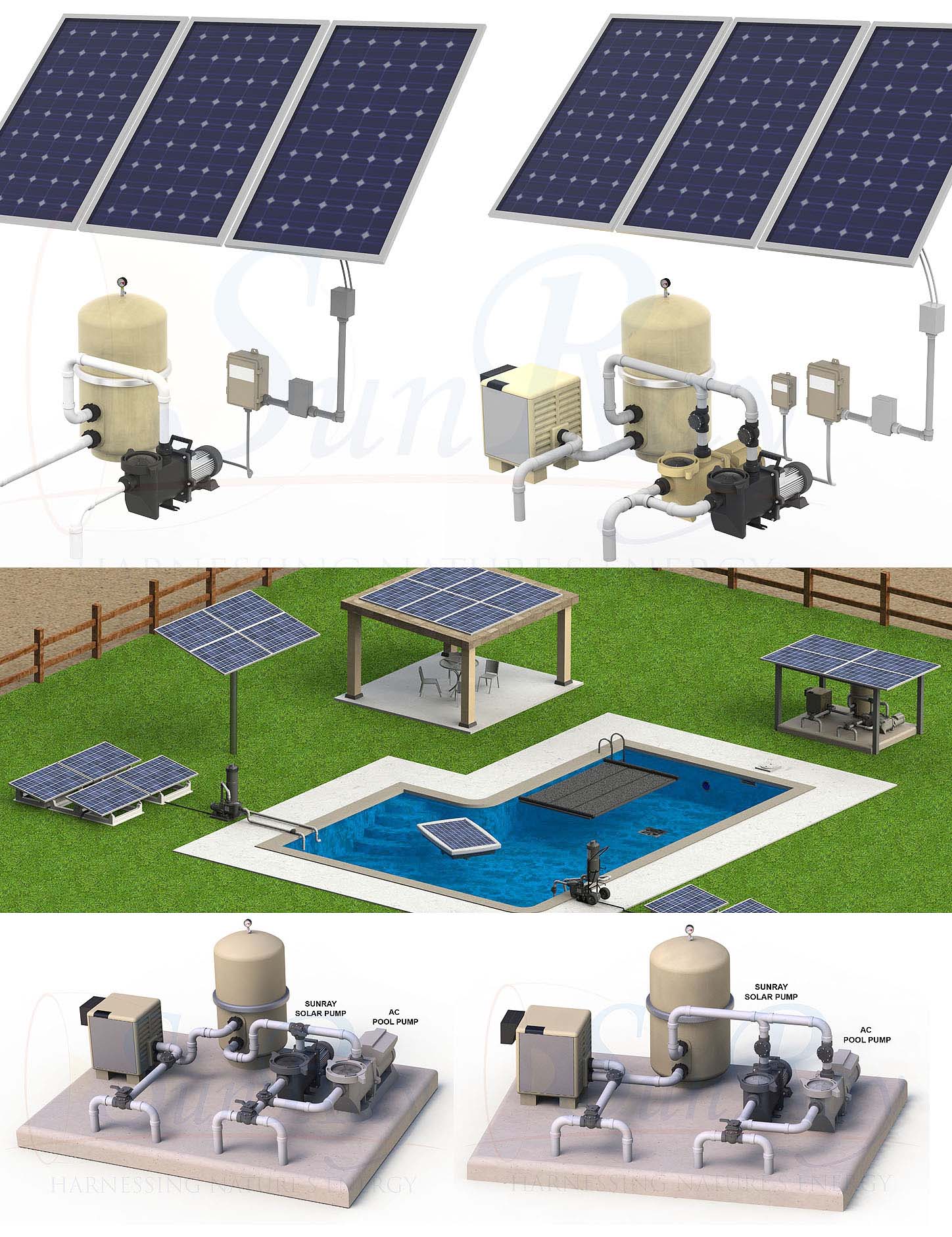
Please Enter Your Swimming Pool Address
60-seconds to get off the grid!
Building or Remodeling?
Install a SunRay Solar Powered Pool Filter Pump.
Call us Today!
(949) 636-4358
Install a SunRay Solar Powered Pool Filter Pump.
Call us Today!
(949) 636-4358
More Reasons to buy a SunRay Solar Pool Pump:
SunRay Solar Pumps are in stock - ready to ship
Pre wired & tested before packing
Ready to install out of the box!
Warranty in the United States
DC GFCI (Disconnect with built in lightning arrestor)
Tested and certified by the F.S.E.C.
SunRay Pumps are designed and manufactured in Dana Point, California USA
Made in America
Healthy, Safe and Clean Water!
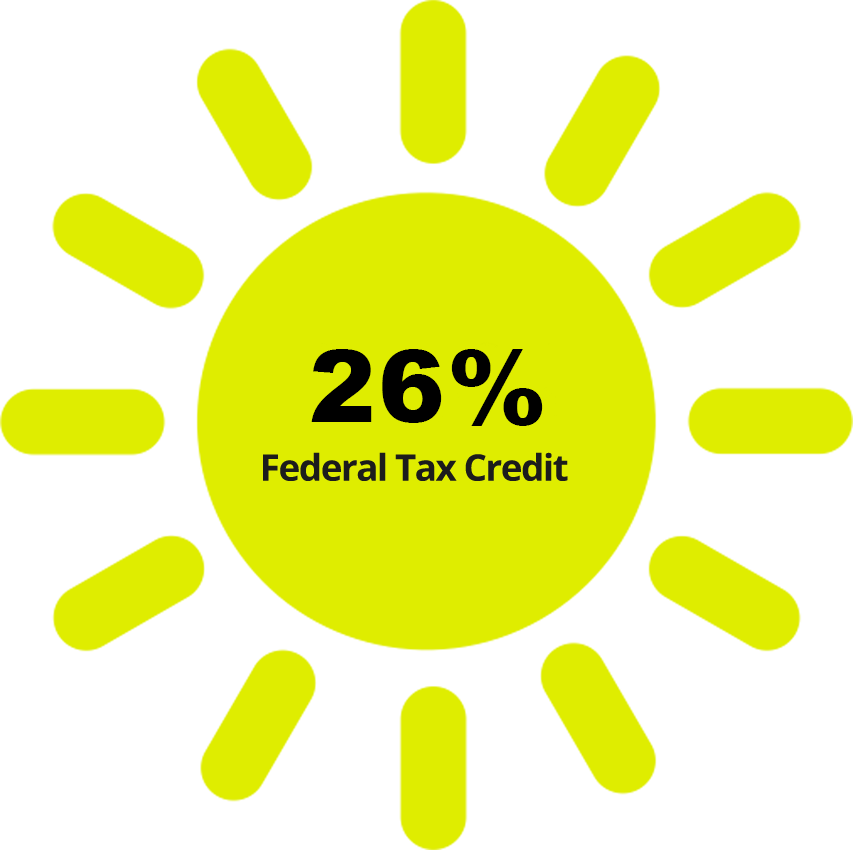

Pump Pool Solar System
Additional Equipment
Handyman or Electritian
Shipping Cost
30% Tax Credit Ends in 2019
Act Today!
Share this website.
Testimonials
Hello, I'm Michael Evingham CEO of Natural Current / SunRay Engineering.
Natural Current has been in the pool business since 1986 and we have thousands of pool owers off the grid with their pool pumps, with zero returns! Not one customer
has ever called and said get this solar pump off my pool. That has never happened and we work hard every day to make sure you're not the first.
Natural Current is the only Pool Pump Manufacturer in the World that has ever won multiple international pool industry trade show awards for
best new product and best green product for our Solar Powered Pool Filter Pumps and our Solar Powered Water Sanitation Systems.
Please rest assured we work hard everyday inventing and engineering solar powered water products and your support and commitment to run our USA made solar power
water products means everything to us! And we will continue groundbreaking work everyday and every year ahead.
Thank you!
Michael Evingham
Natural Current / SunRay Engineering
(949) 636-4358
If I can do it,
you can do it!
you can do it!
Thank you!
Act Today!
First Step: Enter your Swimming Pool Address.
We'll get you the right Solar Pump.
It's what we do!
Let's do it! | Click Here |
Phone Call: (949)636-4358
Whatsapp: +019496364358
Wechat: +019496364358
Live Chat below
Top of the Page - Going Up?
100% online, no phone calls required
GET YOUR SOLAR POOL PUMP QUOTE NOW!
Not sure what you need? We do!
Please enter your swimming pool address



